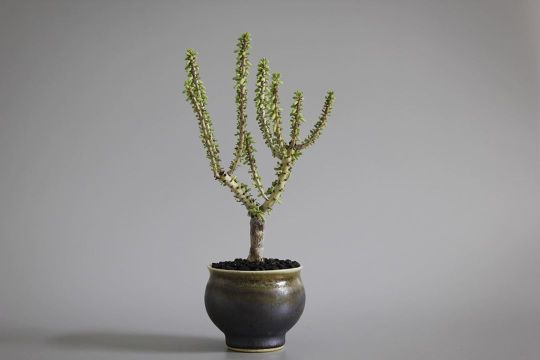#namaquensis
Text
Namaqua Rain Frog

AKA namaqua short-headed frog, Breviceps namaquensis
A round little fellow!
These guys live in Namaqualand and Namibia, in southern Africa. Their toes aren't webbed, and they spend most of their time underground, only coming out after it rains to look for tasty insects.
When threatened, they squeak and inflate to deter predators! I don't think I'd be deterred at all, they're such little cuties!
When they lay eggs, they cover them up in thick yolk-y fluid and the tadpoles live there until grown. Interesting tactic, that.
#frogs#rain frogs#african frogs#brown frogs#namaqua rain frog#namaqua short-headed frog#breviceps namaquensis
15 notes
·
View notes
Text

New video! Why the Namaqua chameleon is INSANELY intelligent.
6 notes
·
View notes
Text

Namaqua Rain Frog (Breviceps namaquensis), family Brevicipitidae, Velddrif, South Africa
photograph by Tyrone Ping
756 notes
·
View notes
Text
For #InternationalChameleonDay :



Chameleons by Robert Jacob Gordon (Dutch, 1743-1795), from The Gordon African Collection, 4 albums of natural history illustrations made during his Cape Colony (South Africa) expeditions (1777-86). Now in the Rijksmuseum collection.
1. Chamaeleo namaquensis (Namaqua Chameleon)
RP-T-1914-17-99
2. Bradypodion pumilum (Cape Dwarf Chameleon)
RP-T-1914-17-101
3. Bradypodion pumilum in three poses (Cape Dwarf Chameleon)
RP-T-1914-17-100
drawings on paper, H 660mm × W 480mm ea.
#animals in art#animal holiday#chameleon#chameleons#International Chameleon Day#Cape Dwarf Chameleon#Namaqua Chameleon#lizard#lizards#African animals#natural history art#scientific illustration#historical sciart#colonial art#Robert Jacob Gordon#The Gordon African Collection#Rijksmuseum#drawing#works on paper
21 notes
·
View notes
Photo


Lachenalia namaquensis
Lachenalia is a genus of bulbs in the Scilloideae subfamily of the Asparagus Family (this subfamily was formerly classified as a family of its own - the Hyacinth Family). Because the lachenalias are mostly from the winter-rainfall area in western South Africa and southwestern Namibia, they are well-suited for cultivation in California and other areas with a Mediterranean climate. In keeping with this, they grow during the cool winter months, and then go dormant during the dry months of summer. Lachenalia takes its name from Namaqualand, in northwestern South Africa.
-Brian
13 notes
·
View notes
Text

Five Old World Mice by Jennifer Rae Kinyak
"I've drawn five old-world mice species—Apomys datae (Luzon montane forest mouse), Aethomys namaquensis (Namaqua rock rat), Tokudaia muenninki (Muennink's spiny rat), Arvicanthis niloticus (African grass rat), and Apodemus sylvaticus (wood mouse)—in colored pencil and marker on vellum. A random-number generator selected these particular critters for me to draw. They're in varying shades of light brown, with their big inquisitive eyes alert to threat or fun."
1 note
·
View note
Photo

200618 ・ ・ 葉の生え変わり時期🍂🌱 いつのまにか伸びてる ・ ・ いつのころかケラリアフルチコーサが欲しいな思って探していたけれど無さすぎて記憶から抜けていた🤪 ・ ・ #ケラリア #ナマクエンシス #ケラリアナマクエンシス #ceraria #namaquensis #塊根植物 #多肉植物 #サボテン #観葉植物 #botanicallife #caudex #cactus #succulent #神戸 #ナマクエンシス_ky https://www.instagram.com/p/CBkh12dljKi/?igshid=13fsv93pmkfsr
#ケラリア#ナマクエンシス#ケラリアナマクエンシス#ceraria#namaquensis#塊根植物#多肉植物#サボテン#観葉植物#botanicallife#caudex#cactus#succulent#神戸#ナマクエンシス_ky
2 notes
·
View notes
Photo

A desert specialist, the Namaqua chameleon (Chamaeleo namaquensis) walking on the sand thanks to its fingers kept flat like snow shoes. They can change their skin tone depending on the temperature: darker when heating is needed, lighter when the sun is high and temperature must be lowered with higher reflectance. #pickoftheday #mostrakryptos #chameleon #namaqua #namaquensis #reptile #herping #herp #herpsofinstagram #survivor #sand #namib #dune @ilcp_photographers (presso Swakopmund, Namibia) https://www.instagram.com/p/BrAUZR_hUdi/?utm_source=ig_tumblr_share&igshid=pll7tepvdd5o
#pickoftheday#mostrakryptos#chameleon#namaqua#namaquensis#reptile#herping#herp#herpsofinstagram#survivor#sand#namib#dune
2 notes
·
View notes
Photo




An update on the Crassula planter! (Can’t remember if I actually posted it before) I’m really happy with the desert-y look I was able to give it. The biggest challenge is that the larger one needs a little more water than the others and it ends up shrivelling quite a bit before I can give it more so the others don’t get overwatered.
The branchy, shrubby-looking on is Crassula sarcocaulis, the textured on is Crassula namaquensis, and the one with the triangular leaves and flowers is Crassula deceptor.
C. namaquensis is my favorite one texturally and it feels like those sugar coated gummy peaches when it needs water!
I’m hoping these can flower at the same time one day since they’d be cool to try and breed!
#crassula#plants#succulents#My ADHD brain loves the stimminess of C. namaquensis so much#plampts#Alex Says Words
96 notes
·
View notes
Text

Namaqua Chameleon, Chamaeleo namaquensis (1777-1786) - Robert Jacob Gordon
#Wonder Rooms#Cabinet of Curiosities#Public Domain#Robert Jacob Gordon#18th Century#Scientific Illustration#Zoology#Animalia#Natural History#Reptilia#Herpetology#Chameleon#Chamaeleo namaquensis
4 notes
·
View notes
Photo








The Namaqua rock rat (Aethomys namaquensis) is a species of rodent in the family Muridae. It is sometimes included in the genus Micaelamys. It is found in Angola, Botswana, Lesotho, Malawi, Mozambique, Namibia, South Africa, Eswatini, Zambia, and Zimbabwe. Its natural habitats are temperate forest, dry savanna, temperate shrubland, subtropical or tropical dry shrubland, temperate grassland, rocky areas, hot desert, temperate desert, rocky shores, arable land, rural gardens, and urban areas.
#rat ABC's#Q#namaqua rock rat#aethomys namaquensis#it has a q in it#there's nothing starting with q for rats#nothing#so you get a species that has a q in the name#of which there are almost none#yes it's cheating#no i don't care#rats#rock rats
29 notes
·
View notes
Photo

Namaqua Chameleon
Chamaeleo namaquensis
#chameleon#namaqua chameleon#lizard#squamata#squamate#reptile#herp#reptilia#herpetology#iguania#chameleonidae#chamaeleo#chamaeleo namaquensis#wildlife#wildlife photography#animal#animalia#animal photography#nature
337 notes
·
View notes
Text

Namaqua Rain Frog (Breviceps namaquensis), family Brevicipitidae, Western Cape, South Africa.
photograph by Tyrone Ping
486 notes
·
View notes
Photo

23 notes
·
View notes
Photo


Tiny, angry, and covered in sand, this juvenile Namaqua rain frog [Breviceps namaquensis] was found in Hopefield, South Africa. These frogs are largely fossorial, and are known to squeak angrily when provoked. Images by iNaturalist user Hendre.
13K notes
·
View notes
Text

Grzimek's Animal Life Encyclopedia. Volume 6: Reptiles. Written by Bernard Grzimek. 1984.
1.) Common chameleon (Chamaeleo chamaeleon)
2.) Flap-necked chameleon (Chamaeleo dilepis)
3.) Carpet Chameleon (Furcifer lateralis)
4.) Cape dwarf chameleon (Bradypodion pumilum)
5.) Brown leaf chameleon (Brookesia superciliaris)
6.) Spectral pygmy chameleon (Rhampholeon spectrum)
7.) Helmeted chameleon (Trioceros hoehnelli)
8.) Namaqua chameleon (Chamaeleo namaquensis)
#reptiles#lizards#chameleons#common chameleons#flap-necked chameleons#carpet chameleons#cape dwarf chameleons#brown leaf chameleons#spectral pygmy chameleons#helmeted chameleons#namaqua chameleons
181 notes
·
View notes